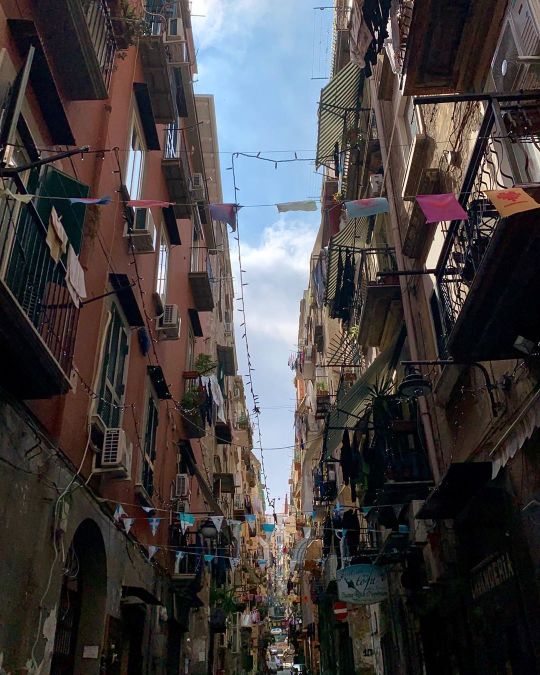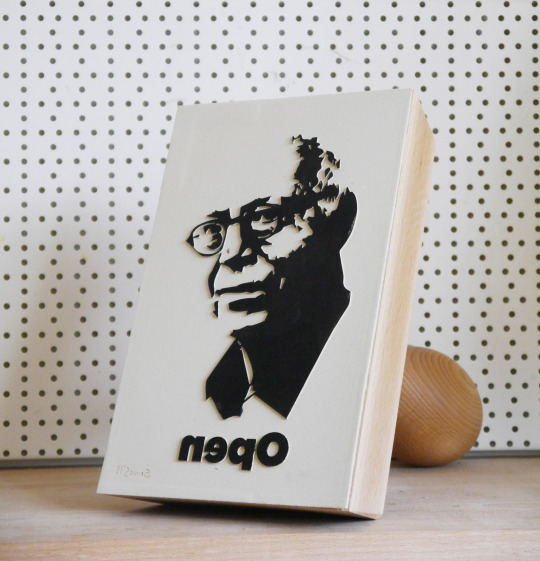
In some Neapolitan travel guides, you’ll find warnings to “not go down small, dark alleyways, especially in the Spanish Quarters.” It’s not bad advice, although often overstated. The Spanish Quarters — known as Quartieri Spagnoli to Italians — is a low-income neighborhood that suffers from high unemployment and a strong influence of Camorra, one of Italy’s oldest crime syndicates. It’s also a city planner’s nightmare, not because of the crime or poverty, but the disarray. The cobblestone streets are tight and narrow, and they’re flanked by peach-colored buildings covered in grime and multiple layers of half-peeled, wheat-pasted fliers. Fresh laundry commonly hangs overhead from the network of clotheslines that crisscrosses between buildings, waving like raggedy banners over the swarms of people below. On warm afternoons, screaming children and roaring Vespas zip alongside each other. Buildings stretch upwards forever, and for some reason, you always have to climb up five flights of stairs to reach the first floor.
The mess that is the Spanish Quarters is part of a larger character that fills every Neapolitan district. It’s not uncommon to find residences next to businesses, sometimes homes located above storefronts or even the two mixed together into the same spaces. Some of the world’s best tailors are located here, as is Mario Talarico, one of the few remaining artisans for handmade umbrellas. And just a stone’s throw away is the affluent, waterfront district Chiaia, which has designer shops, seafood restaurants, and upscale bars. This is Naples: one of the city’s poorest neighborhoods is a short walk from a Prada boutique and Rubinaicci’s flagship, and yet everything coexists in harmony. It’s an equilibrium that has existed since forever. Even in the 1860s, Mark Twain wrote about Naples’ unmatched tempo in his travel book The Innocents Abroad:
The streets are wide enough for one wagon, and how they do swarm with people! It is Broadway repeated in every street, in every court, in every alley! Such masses, such throngs, such multitudes of hurrying, bustling, struggling humanity! We never saw the like of it, hardly even in New York. There are seldom any sidewalks, and when there are, they are not often wide enough to pass a man without caroming him. So everybody walks in the street – and where the street is wide enough, carriages are forever dashing along. Why a thousand people are not run over and crippled every day is a mystery no man can solve.

BUILDING AND DWELLING IN THE OPEN CITY
Richard Sennett, a sociologist at The London School of Economics, calls this an “open city.” His conception of city planning stems from systems theory and stands opposed to the grand ideology of two influential 20th-century urbanists: the Republican city builder Robert Moses and socialist writer Lewis Mumford. From about the 1930s through the ‘60s, Moses was known as New York City’s “master builder.” He moved shorelines, built highways to the sky, and reshaped neighborhoods. For him, urban planning was about transforming a city into an engine for economic growth – people were merely incidental to the project. As Sennett puts it, “he wanted to make Fifth Avenue a highway, run it through Washington Square, from Wall Street to the Upper East Side, to service those financiers and bankers who can’t lose a moment, for every moment back then was a hundred dollars and today a million.”
Mumford, by contrast, was a writer who came out of the garden city movement, which recognized the destructive impact industrialization had on urban centers. He was one of the first urbanists to take technology seriously and was deeply concerned with how city planning affects the human condition. In his book The City in History, which won the 1962 National Book Award, he presented the medieval city as the ideal — a place that fostered a real relationship between people and their living spaces. Urban sprawl, by contrast, was like the sprawling megalopolis of ancient Rome, which ended in collapse. It was alienating and gave rise to broader social problems.
Suburbia didn’t escape his criticism, either. “In the suburb, one might live and die without marring the image of an innocent world, except when some shadow of evil fell over a column in the newspaper,” he wrote. “Thus the suburb served as an asylum for the preservation of illusion. Here domesticity could prosper, oblivious of the pervasive regimentation beyond. This was not merely a child-centered environment; it was based on a childish view of the world, in which reality was sacrificed to the pleasure principle.”
Moses and Mumford didn’t share much in politics, but they both believed in the power of planning. It’s just that Moses wanted to marshal plans for the capitalist class, while Mumford wanted cities to be socialist in character. For Mumford, if urbanism were to flourish anywhere, it would be in the Soviet Union, where the government could organize big, collective projects to achieve their goals. Soviet planning, in the end, proved just as alienating — and even more disastrous — but the central idea of urban planning continues today. Years ago, before he worked on national security for Donald Trump, I had a brief exchange with Michael Anton on StyleForum. Anton wondered why the “thieves, junkies, and hookers” were allowed to take up precious space in the middle of San Francisco, where real estate prices are soaring and every inch can be maximized for profit. His solution: use policy to kick them out.
Sennett’s view of the city is much more anarchic, like a grassroots version of Karl Popper’s Open Society. It takes seriously the concept of noise: that a city should be open not just in terms of its planning, but also its character. For Sennett, a city is a product of the interactions between its residents, and the tissues of community must grow spontaneously at the local level. This is antithetical to the idea of planning because planning is, by its very definition, not about spontaneity. Instead, there’s a very tight fit between form and function — everything is set into place for a purpose.
This closed, overdetermined system is best represented by Corbusier’s “Plan Voisin,” which was a planned redevelopment of central Paris that the architect proposed in 1925. The plan was a utopian urban concept intended to house three million inhabitants in a series of eighteen cruciform glass towers – a sight that would be equally stunning and terrifying. This ideology would later shape public housing projects from Chicago to Moscow, where housing estates became brutalist warehouses for the poor, and vibrant street life was eventually replaced by highly specific districts: one for monofunctional shopping malls, another for gated communities, and another still for isolated school districts and zoned hospitals. This is the logic of efficiency, but as a result, it also separates people. “Everything should cohere!” scream the multiculturalists.
An open city, on the other hand, is chaotic and emergent. Whereas a closed system depends on master planning, an open system relies on seed planning — you plant something and allow the complex tissues of community to grow as they will. That means, in the poorest of communities, you build first-class architecture, libraries, and community centers. You make buildings look as diverse as possible. You do away with historical districts, which are locked into the tyranny of context, and instead, let new architecture emerge as part of a continuity of time. Fundamentally, this is about giving up on the idea that we should live in clean, safe, and efficient environments. Instead, the goal is to build cities so they have dynamic economies, provide cultural stimulation, and do their best to heal society’s divisions around class, ethnicity, and sexual orientation.

“In an open system, the city is to a degree incoherent. Dissonance marks the open way of life more than coherence, yet it is a dissonance for which people take ownership,” Sennett writes. “Against the over-determined vision of Le Corbusier, the urbanist Jane Jacobs argued that places should become both dense and diverse, either in the form of dense streets or packed squares. Such physical conditions can prompt the unexpected encounter, the chance discovery, the innovation which is the genius loci of cities. Healthy, clean, and safe: you can experience these environmental virtues in a suburb, if you are rich enough, but only a certain kind of place, an open city, will stimulate you — and that stimulation comes in particular form. Jacobs says, in a famous declaration, ‘if density and diversity give life, the life they breed is disorderly.’ The open city feels like Naples, the closed city feels like Frankfurt.”
This analytical tool allows us to think about urbanism not just in terms of social theory, but also policy. Sennett continues: “Analytically, it avers that big capitalism and powerful developers tend to favor closure and homogeneity, determinate, predictable, and balanced in form; the role of the radical planner therefore is to champion dissonance. In practical planning, if a city is opened up, it will allow jerry-built adaptations or additions to existing buildings; it will encourage uses of public spaces which don’t fit neatly together, such as putting an AIDS hospice square in the middle of a shopping street. The stimulations of an open city may seem a larger reflection of William Empson’s bon mot that ‘the arts result from over-crowding.’ Jacobs privileges spontaneous combustion: crowd people together informally, and they will compete, collude, gossip, innovate. It’s sheer physical density in itself which is the stimulus.”
These are, of course, not the type of cities we live in today. Even strong, Democratic strongholds have been dramatically changed over the last thirty years through sequential waves of gentrification, making these cities more closed, predictable, and homogenous. In the United States, the emerging economic divide is about home ownership and access to affordable housing. Bruce Cain, a political scientist at Stanford, said in The New York Times: “Upscale liberal whites who consider themselves committed to racial justice tend to be NIMBYists when it comes to their neighborhoods, not living up to their affordable housing commitments and resisting apartment density around mass transportation stops.” As a result, poor people — who are often black and brown — are being pushed out of urban centers and even suburbs. The Bay Area, once racially and economically diverse, is now just a great place to live for people from all rich walks of life.
OPENNESS AS A DRIVER OF FASHION
If cultural capital could be treated like financial capital — privately owned, traded, and protected under the law — poor and multicultural communities would be the new Silicon Valley. In popular imagination, immigrant neighborhoods and downtown city centers are alien worlds that are best avoided. They’re dirty, strange, and unsafe – places you only go on weekends, and then drunkenly stumble out of in the dark. In the 1976 neo-noir film Taxi Driver, the lonely and depressed Travis Bickle drives through NYC with a sense of disgust for its inhabitants. “All the animals come out at night — whores, skunks, pussies, buggers, queens, fairies, dopers, junkies, sick, venal,” he silently thinks to himself. “Someday a real rain will come and wash all this scum off the streets.”
In reality, these places are often incubators for cultural experimentation, social movements, and the earliest stages of pop culture. Take fashion, the most obvious and prosaic example. The ragamuffin style of Kapital is a direct descendant of a derelict look created by hippies and gutter punks — tattered, ill-fitting, and often filthy, it mixes folk clothing, vintage, and military surplus. Martine Rose, London’s of-the-moment designer whose normcore creations predate Vetements, borrows heavily from dance music and drug culture. Christopher Shannon’s FW17 collection, similarly, is full of aesthetic references to rave clubs, which often take place in desolate downtown warehouses.
Demna is so shameless in his lifting that, for his first collection as Balenciaga’s Creative Director, he repackaged an oversized, striped bag that Asian immigrants use for shopping. In terms of the fashion lifecycle, non-white immigrant communities are typically the final resting place before a brand’s death. If a clothing line is sold in Chinatown, it’s well past the stage of being cool. Balenciaga’s “laundry” bag, however, is an example of how brands take from these communities, use their cultural signals, and repackage them with a sense of chic for the uninspired and risk-averse. In Thailand, these cheap, plastic bags are commonly sold for at JJ Market and Platinum Shopping Mall for as little as $2. When made with a French name and slightly upgraded materials, however, the Balenciaga version sold for $2,000.


It would be too easy to say that today’s tattered, hobo aesthetic derives from the poor and homeless. It does, but there’s more beneath the surface. From Comme des Garcons’ “Hole” sweater to Kosuke Tsumura’s “Final Home” coat, many of today’s avant-garde fashions owe themselves to DIY punk culture: The Ramones in New York City and the queer punk attitude of the New Romantics in 1980s London clubs. Punk made it cool to deliberately violate clothes with holes and tears, leaving the garments vulnerable to total ruination. Innercity punk culture also gave us the vocabulary necessary to reintroduce the black double rider as something more than utilitarian outerwear. The Sex Pistols, The Ramones, and Guns ’N Roses, similarly, took their style cues from The New York Dolls, an influential proto-punk band that performed in feminine dresses, long hair, and glitter-glam make-up. And The New York Dolls took their look from the “genderfucking” radical drag of transgender sex workers who came out after the Stonewall Riots, which were a series of protests against police raids at a popular Greenwich Village bar.
In an old New York Times article about the Olson twins’ boho style, Leslie Savan describes dressing poor as a kind of “aesthetic corrective.” “If you can’t reform your social attitudes, you can at least reform your look,” she said. “Mixing the inexpensive and the expensive, the old and the new, seems to make you more interesting, mysterious, and textured.” Today, we’re seeing a new migration in America where educated, middle-class people are flooding into cities to work in knowledge-intensive service sectors. They’re also adopting the poor, boho look of the people they’re displacing, but creating very little of any aesthetic themselves. For a variety of reasons, cities – and often fashion capitals – are becoming increasingly homogenous, closed, and predictable. Diversity isn’t just important for social and economic justice, it’s a fount of inspiration for creative industries such as fashion. Fringe communities give us our language of cool, and it’s the overcrowding of different people that allows for so much innovation.
Last month, I was having dinner with Nicholas Templeman while he was visiting San Francisco. We were talking about how London and San Francisco have changed, and I mentioned to him that I came to the Bay Area to be around all the things I read about as a teen: the radical protest movements, the beat poets and philosophers, and the underground music scenes. But when I arrived, the cafe where Allen Ginsberg wrote Howl was filled with the same microbiology and econ students, who were much like me. Haight-Ashbury only had tourists, and The Mission, a historically working-class, Mexican neighborhood, was in its final stages of gentrification. The things Nicholas noted about London also didn’t sound too unfamiliar: how “hip” districts are just full of the same raw denim shops and artisanal restaurants, and how soaring rents are driving out working class people. To be sure, there will always be culture and designers will continue to borrow from different communities. But one wonders if there’s not a reason why we’re continually looking backward in time for inspiration – and whether we’re seeing the closure of fashion cities.
